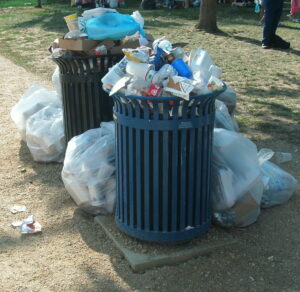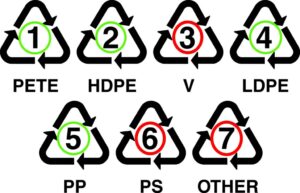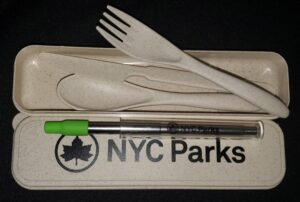Rethinking the cost of Trash
It is no secret that NYC agencies, like the NYC Department of Parks and Recreation and the NYC Department of Sanitation (DSNY) have suffered significant budget cuts as a result of the COVID-19 pandemic. At the same time, parks and open spaces are experiencing larger crowds because people need to get out of their apartments and parks are a safe place to social distance. While we are all grateful for the essential services parks provide, increased use combined with a cut in agency resources is a recipe for trash pile up. Trash is a social, economic, and environmental issue. Before the pandemic, New York City was taking steps towards zero waste, including piloting a compost program. However, funding shortfalls caused by the pandemic have prevented the full roll-out of zero waste efforts. With everyone’s budget affected by the pandemic, there has never been a more necessary time to live more sustainably.
Here are three ways to rethink the economic cost of trash:
-
There is more demand for waste management services than budget
 Before the pandemic, while awareness was increasing, many city residents did not consider the fate of waste and recyclables, let alone the cost of managing them. Just over 20 years ago, all of New York City’s trash could be transported by barge to Fresh Kills Landfill on Staten Island. With the closing of the landfill, each borough became responsible for the collection, handling and off-site transport of garbage. Trash is now shipped to other facilities in upstate New York, South Carolina, Pennsylvania and Ohio at a cost of about $400 million/year. Due to revenue loss and the resulting budget cuts, local municipalities, non-profit open space partners, and businesses have less budget for waste. In addition, waste collection logistics are in flux. In residential neighborhoods where people are staying at home and public spaces are in greater demand, sanitation trucks on some routes are filling up faster than they did pre-pandemic. Other neighborhoods have remained relatively clean because offices are closed and there has been a loss of tourism. Awareness that there is more waste than the available budget can handle should encourage more sustainable choices about purchases and packaging. More informed choices about purchasing can help reduce the number of trips dedicated to taking out the trash and help reduce the trash piling up on sidewalks and streets.
Before the pandemic, while awareness was increasing, many city residents did not consider the fate of waste and recyclables, let alone the cost of managing them. Just over 20 years ago, all of New York City’s trash could be transported by barge to Fresh Kills Landfill on Staten Island. With the closing of the landfill, each borough became responsible for the collection, handling and off-site transport of garbage. Trash is now shipped to other facilities in upstate New York, South Carolina, Pennsylvania and Ohio at a cost of about $400 million/year. Due to revenue loss and the resulting budget cuts, local municipalities, non-profit open space partners, and businesses have less budget for waste. In addition, waste collection logistics are in flux. In residential neighborhoods where people are staying at home and public spaces are in greater demand, sanitation trucks on some routes are filling up faster than they did pre-pandemic. Other neighborhoods have remained relatively clean because offices are closed and there has been a loss of tourism. Awareness that there is more waste than the available budget can handle should encourage more sustainable choices about purchases and packaging. More informed choices about purchasing can help reduce the number of trips dedicated to taking out the trash and help reduce the trash piling up on sidewalks and streets.
-
Wishcycling: Not everything can be recycled
The idea of recycling seems simple enough: paper, glass, metal and plastic can be recycled and repurposed. However, the practice and the process are a bit more complicated, and in that confusion, many hopeful recyclers are actually wishcyclers. Wishcyclers place the wrong items in the blue bin with the hope the item will be recycled. These wistful thoughts will derail our path to more sustainable choices by hindering recycling efforts. Placing non-recyclable items in the wrong stream ends up costing the recycling center time and money, may compromise batches of recycled plastic—and your item still won’t be recycled. To complicate matters, recycling rules vary from one municipality to the next and  many green plastics aren’t recyclable (or home compostable). You can assist recycling efforts by reducing single use items and becoming more familiar with recycling laws in your area. Better recycling habits help recycling centers run more efficiently while reducing our outsourced waste. And remember that reducing waste and/or reusing materials is more effective in curbing your waste than recycling.
many green plastics aren’t recyclable (or home compostable). You can assist recycling efforts by reducing single use items and becoming more familiar with recycling laws in your area. Better recycling habits help recycling centers run more efficiently while reducing our outsourced waste. And remember that reducing waste and/or reusing materials is more effective in curbing your waste than recycling.
-
Reusable cutlery helps everyone
Did you know that using reusable cutlery and straws helps local businesses and the agencies that are responsible for waste collection? In every food vendor’s operating budget is a single use cutlery expense (which usually includes, forks, spoons, knives, straws, napkins, condiments). While you normally wouldn’t think twice about the forks and straws provided with takeout, they add up for the business owner who may be operating on reduced profits. The price of 100 unwrapped forks can cost over $2 wholesale, over $11 if wrapped, and over $16 wrapped with a napkin. In addition, City agencies have only so much physical and fiscal capacity for waste removal, and all those forks add up! About 100 forks can weigh up to 1 pound.  For reference, the average person generates 4.5 pounds of waste per day. If more people opt out of single use cutlery by simply carrying reusables, especially when ordering from home, we could reduce our trash output, help local businesses recover, and assist essential workers. You could also avoid the plastic vs paper straw debate entirely by having your own re-useable straw.
For reference, the average person generates 4.5 pounds of waste per day. If more people opt out of single use cutlery by simply carrying reusables, especially when ordering from home, we could reduce our trash output, help local businesses recover, and assist essential workers. You could also avoid the plastic vs paper straw debate entirely by having your own re-useable straw.
We are in this together and the less we collectively throw out, the more we can collectively save. Have a sustainability tip? Share with us on social media by tagging us @freshkillspark.
Explore The 1,2,3’s of Recycling Further
After the Recycling Bin – Learn about the recycling process
It’s all Downcycled from Here – Recycled plastic is downcycled plastic
Bioplastic, It’s Fantastic? – Green plastics aren’t always “green”
The 411 on cell Phone Sustainability – Cut the plastic from your phone plan




